|
A glimpse into the past...
October 20, 1921.
Rook seems to be the popular card game in Keota. There are a number of
clubs in town.
January 25, 1923.
People of the Keota community have revived the old time dances, and
there have been four gatherings in the last week of people from
different neighborhoods. The dances are held in the hall above the post
office.
August 16, 1923.
A group of Keota tennis players met Monday night and organized a tennis
club, to be known as Keota Tennis Association. The Town Council
permitted them to locate the courts in the southeast corner of the city
park, just north of the east entrance. Officers are Dr. Pershing,
President; Sheldon Morris, Secretary; Harold Russell, Treasurer.
March 12, 1925.
Keota Rifle Club organized. The Keota Rifle Club was organized at the
Legion Club, March 5, and will be affiliated with the National Rifle
association and recognized by the government. The object is expert
marksmanship. President-Troy Sellman; Vice-President-Frank Lillig;
Secretary-A. L. Richardson; Treasurer-Harold Teets; Executive
Officer-M. P. Wilkinson.
August 7, 1930.
Miss May Marr has built a miniature golf course at her home a block
south and a block west of the Keota Depot, the course being laid out on
the lawn west of her house. Miss Marrs is what is known as a Tiny
Miniature Golf Course. It has 18 holes and par is 41. Regular golf
clubs and golf balls are used—putters being used on all shots except
where a niblick is necessary. The player pays 25¢ for each game. Clubs
and balls are furnished.
September 11,
1930. Mrs. J. O. Singmaster let the contract for transformation of one
of the large horse barns into a dance pavilion. A hard maple floor 35 x
80 is being laid rooms are being partitioned for rest-rooms, cloak room
and refreshments. It will be called Sing's Stables and will be open
September 18. The orchestra will be Walla Standard and his Merrymakers
of Galesberg, Illinois, including Miss Gawthrope, singer. Admission
$1.25 per couple—extra lady 25¢. About 130 couples were in
attendance
the opening night.
LECTURE
COURSE
The lecture
courses were a fine source of entertainment for the people of Keota. As
early as 1906 the Midland Lecture Course was practically assured for
Keota with the sale of 200 tickets at $1.50 for adults, $1.25 for high
school and children under 14, $1.00, for a season ticket. The programs
were held during the winter months at the different churches and were
of an educational and musical nature.
TENT
SHOWS
Tent shows
playing for a week at a time with a different play each nite played in
a tent just west of the park. In 1914 Frank Jersey's Big Tent Show Co.
opened in Keota July 27. They presented such plays as Jane Eyre, Rip
Van Winkle, Ten Nights in a Bar Room and many more and had fine crowds.
CHAUTAUQUA
Chautauqua was
another very good source of entertainment, providing some excellent
programs. It was started in Keota in 1910 by the W.R.C. "The tent was
located in the extreme northeast corner of Independence Park so that
boys may have room for their ball games." From the June 12, 1919, Keota
Eagle the editor states that — Keota's Chautauqua June 8-14 was very
successful. There were airplane flights — probably 75% of our people
had never seen an airplane. The machine appeared and alighted in a
field south of the chautauqua grounds. The aviators consented to take
passengers for a ride, at $20 per spin. Several young people took
rides, among them Cloyce Hamilton, Lawrence Peiffer, Dewey Coffman and
Ed Flander.
June 15, 1916.
Special telephone service from the chautauqua grounds to several homes
were placed so that invalids could hear music and lectures.
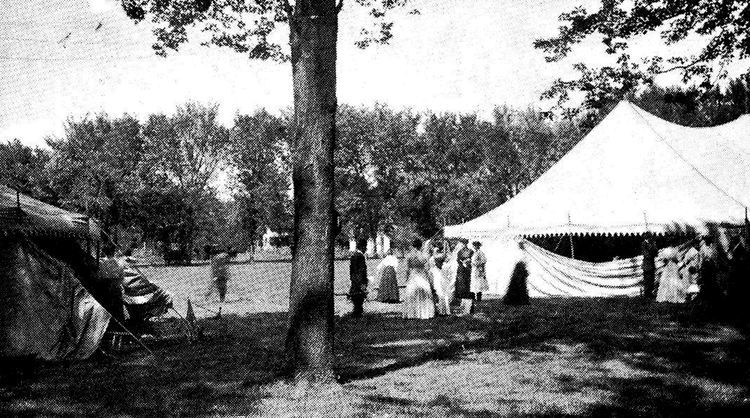
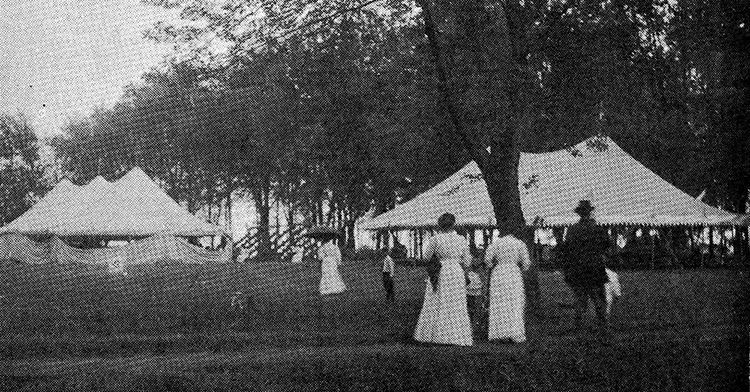
Chautauqua tents in the park.
31
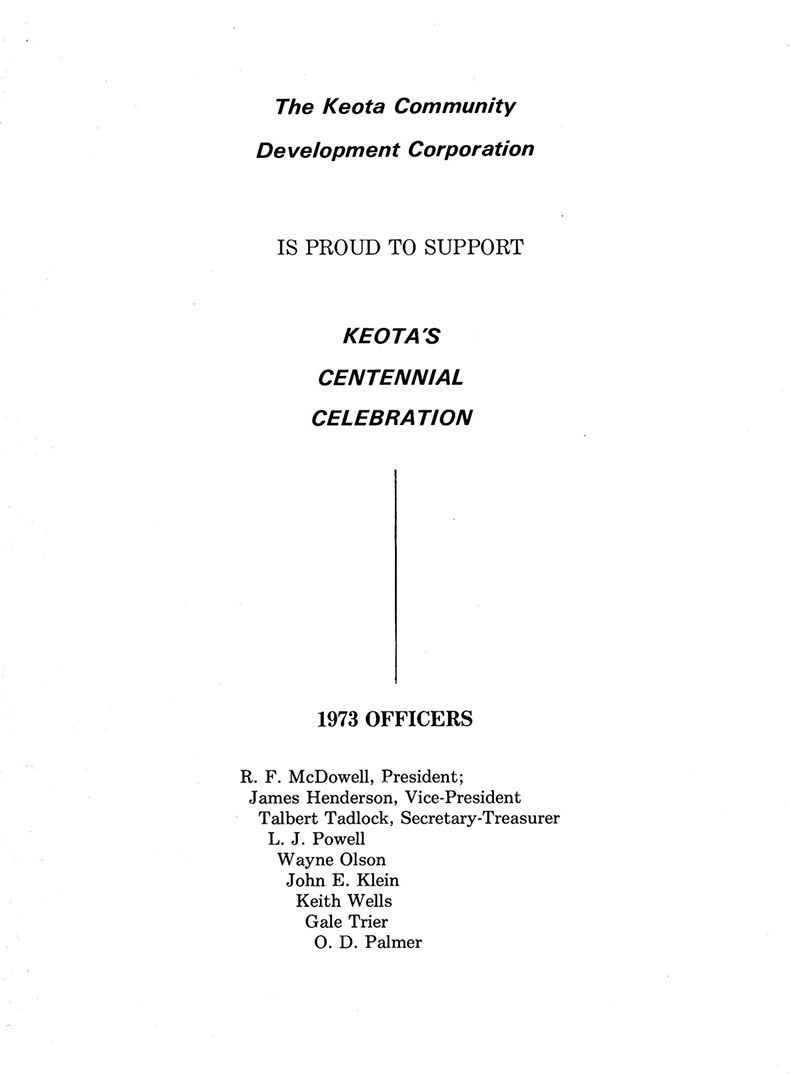
32
A glimpse into the past...
OPERA HOUSE
August 26, 1882.
A project in view and that was to convert the Eagle Glass Works into a
town hall. At this time there were two idle church building in town.
February 10,
1883. The Opera House is nearly ready for occupancy. The young folks
will have a dance in it first. The Library folks called to elect
officers. They will probably give us an entertainment as soon as they
can make the necessary preparations.
We'll make Sam
Wise one of our saints for giving us the opera house.
February 17,
1883. The Opera House is now finished and ready for occupancy.
March 10, 1883.
"Michael Earl" a beautiful drama will be presented at the Keota Opera
House, March 11, under the auspices of the Keota Library Ass'n.
March 17, 1883.
The mania for roller skating has struck the young folks of this town.
They used the Opera House every night for a week or so, till Sam Wise,
the owner, examined the floor and vetoed the performance. Now they want
the glass house. It would be a boss place for the amusement if properly
fixed, rather than remain idle.
March 31, 1883.
J. O'Brien now has control of the Opera House. Parties who desire to
rent it, will please call on him at The American House, Keota, Iowa.
June 9, 1883.
Work on the Glass House has started. It is being re-modeled and changed
to a Hall or Opera House and skating rink. The east end about 70 x 50
feet will be converted into the Hall , leaving about 40 x 50 feet in
the west end for a skating rink, election and other purposes.
The building will
be plastered, new windows, large stage, good scenery and seats will be
put in. It is hoped to have it available by July 4th for dancing and
skating.
June 16, 1883.
The Opera House Hall will have high arched ceilings, large stage with
dressing rooms at each side. These rooms will open into the skating
rink and serve as cloak rooms for skaters.
July 21, 1883.
Charles Gray, a Keokuk County boy of whom we are all proud, has the job
of painting the scenery for the new Opera House.
September 1, 1883
The new Opera
House was opened last Tuesday night by H. Minora Raymond who gave a
concert to a large audience.
The hall is
finished except for the chairs. The scenery painted by Charles Gray,
the noted artist is excellent. The front curtain represents a moonlight
scene in Venice. The second drop curtain represents an old farm house
on the hill side. The third curtain is a kitchen scene and is so real
that one feels like looking through the window to see if the hired girl
has dinner about ready.
The fourth, or
stationary curtain has a garden wall whose steps look so real, one
might imagine that lovers just landed from the gondola might step over
them and wander arm in arm into mountains beyond.
August 13, 1903.
Keota's old glass factory Opera house may soon be a thing of the past.
J. L. Ramsey, the owner, tells us the building has just barely paid
expenses for some time and he is "tired of it". Mr. Ramsey's thought of
tearing it down and use lumber to build a cottage on each of three lots
but since private parties have approached him he may sell the entire
property.
October 1, 1903.
J. L. Ramsey will build two cottages or rather small residences at once
on Opera House patch of ground. They are 30 x 16 and 14 x 14, 7 foot
stone foundation and basement, two story, seven rooms and city water.
October 1, 1903.
One can plainly see the way the school entertainment went off at the M.
E. Church, Friday night that "show business" is going to be an uphill
business in this town so long as we're minus an opera house. The
churches are all right in their way but they were not built for that.
Keota must have a play house of the proper sort.
October 3, 1903.
In tearing out the old opera house glass works foundation, Frank Glover
ran across a bottle imbedded in rock containing a couple copies of The
Keota Eagle, one being dated June 28, 1879. Turning to our files of
that date we find the editor, George L. Reed, was piling up enthusiasm
for the "Eagle Glass Works" of Keota, which was being built at that
time. The failure of the "Glass Works" shows how easily men can be
deceived by promise of gold at rainbow's end. Fact is, this wasn't cut
out to be a manufacturing town. It's an agricultural burg, pure and
simple, maintaining its prestige by reason of the rich farming country
in which it is centrally located.
PETRIFIED WOMAN
March 18, 1887.
Some 30 years ago in 1856 before Keota was started, a family by the
name of Hill owned a good deal of the land on which Keota is now
located. The mother sickened and died and was buried in a grave just a
little south and west of the old glass factory. The deceased weighed
about 300 pounds at the time of her death. It is said the grave was
marked by a tree.
A number of years
later friends of the deceased lady wanted to remove the remains to the
Center Cemetery for a more decent burial. The party designated for that
purpose dug down until the coffin was reached and found it well
preserved, but they could not move it. After getting more men to help,
the coffin was finally raised and opened and found the large body
completely petrified. It is said the hair and shroud had turned to
beautiful white stone. The coffin was taken to Center Cemetery and
buried, and today no one knows exactly where the body was buried. An
Eastern gentleman offered the deceased woman's husband quite a large
sum of money for the body to be put in a museum, but the offer was
refused. This information was gathered while talking with several old
residents of the vicinity, and we give it for what it is worth. The
soil where this body formerly lay must have a peculiar formation.
33
34
A
glimpse into the past...

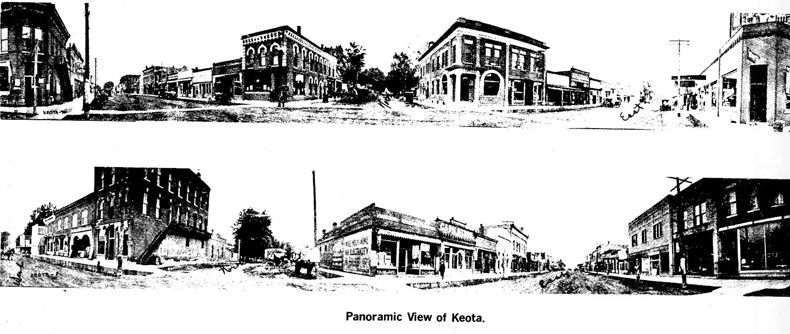
35
36
A glimpse into the past...
HITCHRACKS AND SIDEWALKS
June 24, 1887.
The businessmen along Broadway east of the bank had a line of
substantial burr oak hitch racks put up which will be quite a
convenience to the farmers.
July 17, 1902.
George Helscher makes a good suggestion—that the town (or
businessmen)
buy John Millhouse's idle feed yard and convert it into a hitching
place for teams, build racks along the side streets for such teams as
that space would not accommodate and then make a rule that no horses
shall be allowed hitched on Broadway. Take it in a wet season, as this,
and the hitching rack nuisance on Broadway, bad enough at best, is
well-nigh intolerable.
March 5, 1903. A
semi-laughable mix-up on Broadway vindicated The Eagle's position on
the hitchrack question. A lumber wagon and a top buggy locked wheels
trying to back out and pass each other and the lumber wagon's team took
fright and made a bee-line for Bower and Sanders store front and it was
only by herculean efforts that they prevented from dashing up the
Central office steps. Guess they wanted to call the police. Moral of
tale is: remove the hitch racks.
October 15, 1903.
A lot of concrete sidewalks are being constructed on Center
Broadway—H.
Henkle, Leinen and Son, and Hulse and Co. It is very likely Farmers
Savings Bank and Mrs. D. McFarlane will follow suit. This will give a
hard sidewalk from the new Henkle block to the Star Drug Store. It
figures about $48 for each with a little extra for curbing.
July 20, 1904.
Poles with cable connections have been put on each side of the State
Bank, on Fulton Street alongside the old Hammes building, and on Green
street opposite H. L. Papes' blacksmith shop. A dandy is along the
north side of the park. A hitchrack is not a desirable institution in
front of any man's door but it is for the town's common good.
October 17, 1907.
Keota needs more hitch racks. Saturday afternoon everything that a
horse could be tied to was utilized and we heard some grumbling. One
man said he'd go to Harper to tie his team, which we do not suppose he
meant literally.
May 9, 1912. The
last board sidewalks on Broadway have been torn out, in front of J.
O'Brien's and John Longman's. The town furnished dirt to fill in and
the owners will put in cement walks.
July 16, 1914.
The council has put in some fancy hitching racks on Fulton street near
the State Bank, made of 4" gas pipe and set in cement. They ought to
last for ages.
DRINKING
FOUNTAINS
June 11, 1903. At
its meeting last Thursday night the council ordered a public drinking
fountain on Broadway. Because of the old well in front of Bower and
Sanders store it will be placed there. They will tap the main across
the street in front of Holmes and Son's store and will run a pipe back
to the well and a coil down into it twenty-six feet so that the water
will be cool in the hottest weather. Contract has been let and
estimated to cost between fifty and sixty dollars.
July 16, 1903.
The drinking fountain arrived and is installed. It really is a neat and
convenient improvement. The fountain is of metal and has two faucets.
July 14, 1904. A
new drinking fountain with two spouts on it will be located at the east
corner of the new bank building. It is like the one in front of Bower
& Sander's Store. Town appropriates $45.
JAILS
March 18, 1882.
The Town Council has decided to build a Hotel de Tramp, which being
translated means cooler (jail). It will be located south of the depot,
just beyond the railroad limits.
April 1, 1882.
The cooler is finished being boarded up with surfaced lumber and has a
cupola pointing upward a la smokehouse and presenting rather
un-inviting appearance to the rusty tramp. It is now ready for
customers.
February 17,
1887. Mayor J.L. Ramsey in an address to the city council recommended
that the calaboose be moved to the south end of the lot on which our
Town House stands. When it was erected the town owned no lot and was
necessitated to build it in the alley, where it now stands.
February 7, 1890.
A petition is being signed by the south siders to move the "cooler" to
a less prominent place. Why not set it on the town lot and enclose it
with a good high fence. That would be the place.
July 9, 1903.
Keota will soon have a modern steel cage in which to put its drunks
instead of the old "cooler." They have contracted for one to be 10 x 13
and 6 1/2 feet high, divided into two compartments, each supposed to
hold two cases. The expensiveness of it is to be $198. They intend to
put it in the court room about where the voting booths have been
located.
August 23, 1906.
The town cooler is no more. Clark Nelson bought it for $25.00 for a
coal shed. Then Berend and Allender concluded they needed it for a
cement shed so bought it from Nelson for $35.00. It is being moved
today to a location near the old mill.
March 18, 1937.
Only the steel jail cells remain in the old town hall and the council
will have them removed to the rear end of the new fire hall.
Note: Apparently
times are now much better as far as jails go because March 1973, 91
years after the first mention of jails in Keota, we do not have a jail.
37

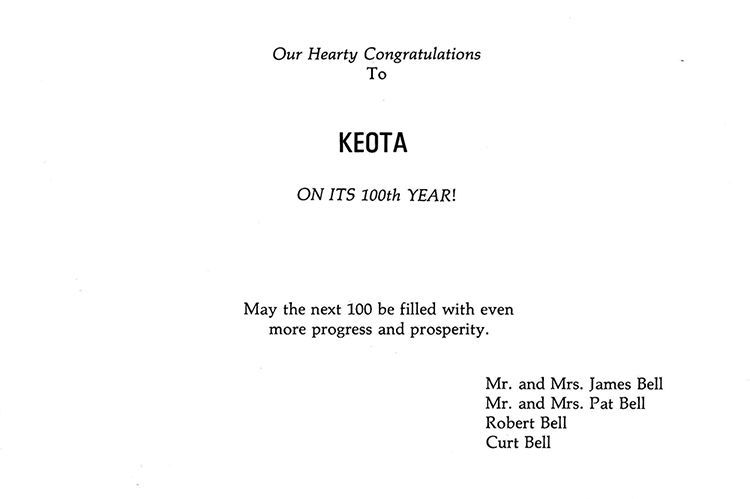
38
A
glimpse into the past...
"GENERAL
PARROTT"
The Cannon In The Park
July 14, 1910.
The W.R.C. ladies asked permission of the city council to build a
suitable pedestal for mounting the old gun. The council gave them a
piece of ground 24 x 41 feet for the purpose. The W.R.C. Ladies and the
G.A.R men dismounted the gun and prepared a place for it. A concrete
pedestal was made for it. F. M. Smock designed the foundation and
constructed the form and John Berend made the concrete and did the
troweling. The old gun will stand within the park gate, to the right of
the road as you drive in. A flower bed 24 x 41 feet in extent will be
built and the gun's old wooden wheels will be imbedded in dirt and
flowers will grow between the worm-eaten spokes.
General Parrott,
as the old gun has been called, came from the arsenal at Rock Island
and was bought by popular subscription by the citizens when Keota was
not more than three or four years old. The gun cost $120.00. The
original gun was originally three and a half feet longer. On one
occasion the early townsmen became over enthusiastic about making a
loud noise and they packed General Parrott's muzzle with clay before
touching off his breech and busted the bar'l and General Parrott had to
be sent to a foundry where three feet of his muzzle had to be amputated.
November 10,
1910. F. M. Smock sent to the government arsenal at Philadelphia for a
lot of cannon balls. The object is to make a pyramid of them, military
fashion, and to keep General Parrott company. There are fifty-five of
them. They are not cannon balls, they are shells and are eight inches
in diameter and weigh 44 pounds each. They were made to be fired from
eight-inch siege guns. In loading them, they were filled with cannister
and powder and set off by a time fuse, which was ignited by the flash
of the charge in the gun.
The G.A.R and W.
R. C. are promoters of this project.
Note: On October
25, 1879, "General Parrott", manned by Major Brier and drawn by four
mules, went to Sigourney to celebrate the democratic election. He was
unused to war, and broke down on the road coming back and was laid up
for repairs.

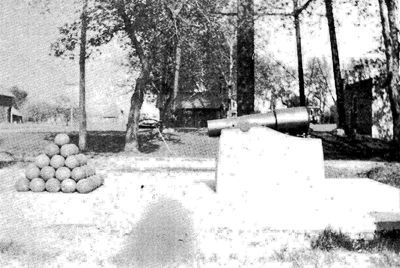
**********
Statement showing
the receipts and expenditures of the Town of Keota, for the year ending
March 4th, 1878.
| Balance in Treasurers hand from last
year. . . . . . . . . . . . . . . . |
$ .69
|
| Arn't rec'd from sale of Cemetery lots. . . . . .
. . . . . . . . . . . . . . |
92.75
|
| Am't rec'd from Peddlers license. . . . . . . . .
. . . . . . . . . . . . . . . |
52.50
|
| Am't rec'd from License, beer and billiards. . .
. . . . . . . . . . . . |
631.66
|
| Arn't rec'd from Pound fees and sales. . . . . .
. . . . . . . . . . . . . . |
65.75
|
| Total |
$843.35
|
| Paid out on unpaid orders of '76. . .
. . . . . . . . . . . . . . . . . . . |
$ 39.50
|
| Paid out for Secretary salary '76. . . . . . . .
. . . . . . . . . . . . . . |
15.00
|
| Paid out for Treasurers salary '76. . . . . . . .
. . . . . . . . . . . . . |
15.00
|
| Paid out for stone culvert on Broadway. . . . . .
. . . . . . . . . . |
142.60
|
| Paid out for improvements of Park. . . . . . . .
. . . . . . . . . . . . |
92.45
|
| Paid out for fire ladders, hooks, buckets, etc. .
. . . . . . . . . . |
62.90
|
| Paid out for improvements of Cem. . . . . . . . .
. . . . . . . . . . . |
147.25
|
| Paid out for spring election of '77. . . . . . .
. . . . . . . . . . . . . . |
10.00
|
| Paid out for Attorneys fees. . . . . . . . . . .
. . . . . . . . . . . . . . . . |
12.50
|
| Paid out for materials for street crossings. . .
. . . . . . . . . . . |
50.99
|
| Paid out for printing. . . . . . . . . . . . . .
. . . . . . . . . . . . . . . . . . |
16.50
|
| Paid out for establishing grade on Broadway. . .
. . . . . . . . |
5.00
|
| Paid out for extra police (Burning of Farris
barn). . . . . . . . |
3.00
|
| Paid out for Sec. salary '77. . . . . . . . . . .
. . . . . . . . . . . . . . . . |
15.00
|
| Paid out for Treas. salary '77. . . . . . . . . .
. . . . . . . . . . . . . . . |
15.00
|
| Paid out for Marshal's salary '77. . . . . . . .
. . . . . . . . . . . . . . |
290.55
|
| Paid out as interest on order. . . . . . . . . .
. . . . . . . . . . . . . . . |
2.62
|
| Am't of cash on hand. . . . . . . . . . . . . . .
. . . . . . . . . . . . . . . . |
9.85
|
| |
$945.84
|
| Less the am't of unpaid orders. . . . . . . . . .
. . . . . . . . . . . . . |
102.49
|
| Total |
843.35
|
39
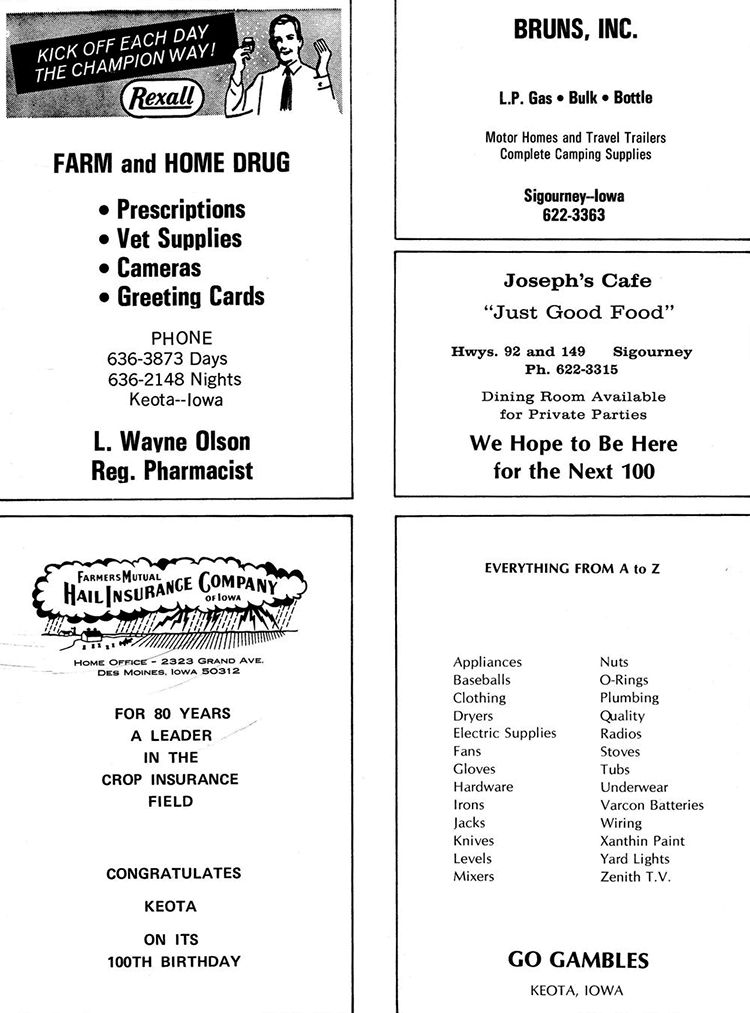
40
|